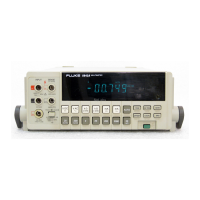Theory of Operation
A/D CONVERTER
5
5-17
f5-10.wmf
Figure 5-10. First Remainder-Store Period
This five-interval process thus generates five nibbles which are processed by the In-
Guard µC to produce one A/D sample. After the fifth nibble is generated, U101 interrupts
the In-Guard µC over line INT. The In-Guard µC then pulls line CS7 low five times,
causing U101 to send the µC the five (six-bit) nibbles one-at-a-time over lines AD0-
AD5. The In-Guard µC then weights each nibble 1/16 of the value of the previous
number and calculates the input voltage.
The hardware for the A/D Converter has four major sections: Timing/Data Control,
Precision DAC, A/D Amplifier, and bootstrap supplies.
5-21. Timing/Data Control
The Timing/Data Control circuit (the digital portion of U101) times and controls the A/D
Converter by manipulating the switches in the A/D Amplifier and the bit-switches in the
Precision DAC. An A/D conversion cycle is triggered by the falling edge of line TR from
the In-Guard µC. Once triggered, the A/D Converter (under control by U101) generates
the five 6-bit nibbles without further interaction with the In-Guard µC.
The Timing/Data Control circuit also provides a watch-dog timer (line RES not) which
resets the In-Guard µC in case normal program execution is interrupted. If the timer
senses inactivity on line CS7 for longer than 1.5 seconds, it resets the In-Guard µC by
pulling RES not low.
The Timing/Data Control circuit is supplied with a fixed-rate 8 MHz clock and provides a
1 MHz output clock for the Keyboard/Display Interface (U212). In addition, four output
lines (PC, HD1 not) TR1, and TR2) provide control signals for the Track/Hold circuit.
5-22. Precision DAC
The Precision Digital-to-Analog Converter (DAC) is composed of DAC Amplifier
U102B and a binary ladder network, which consists of resistors in Z101 and digitally
controlled analog bit-switches contained in U101.

